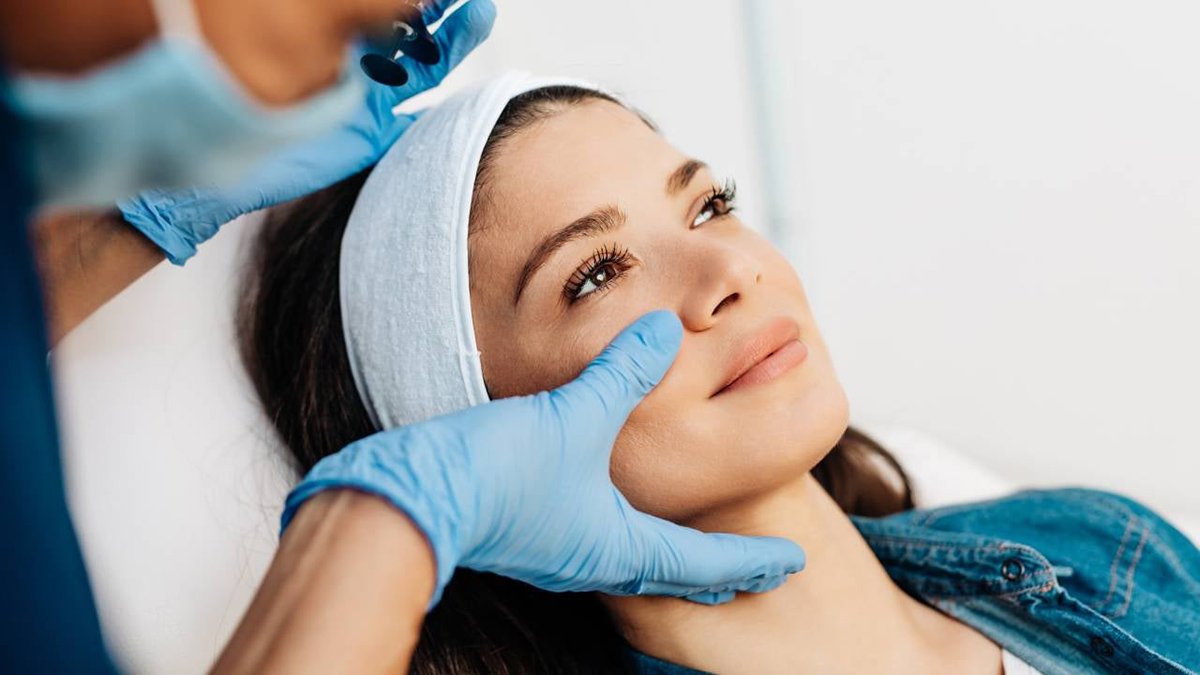Home>Finance>How To Get Plastic Surgery Paid For By Insurance


Finance
How To Get Plastic Surgery Paid For By Insurance
Published: November 14, 2023
Learn how to finance your plastic surgery with insurance coverage. Discover the steps to get your procedure paid for by insurance and save on out-of-pocket expenses.
(Many of the links in this article redirect to a specific reviewed product. Your purchase of these products through affiliate links helps to generate commission for LiveWell, at no extra cost. Learn more)
Table of Contents
- Introduction
- Understanding Insurance Coverage for Plastic Surgery
- Step 1: Determine if Your Procedure is Medically Necessary
- Step 2: Research Your Insurance Coverage and Policy
- Step 3: Consult with Your Plastic Surgeon
- Step 4: Obtain Pre-authorization from Your Insurance Company
- Step 5: Follow the Required Documentation Process
- Step 6: Submit Your Claim
- Step 7: Appeal if Your Claim is Denied
- Conclusion
Introduction
Plastic surgery has become increasingly popular in recent years, with more individuals seeking cosmetic enhancements to improve their appearance. However, the cost of these procedures can be a significant hurdle for many people. Luckily, in certain cases, insurance coverage may be available to help offset some or all of the expenses associated with plastic surgery.
While insurance coverage for plastic surgery can be a complex and often confusing process, understanding the steps involved can greatly increase your chances of having the procedure paid for by your insurance provider. In this article, we will guide you through the essential steps necessary to navigate the insurance system and maximize your chances of success.
It is important to note that not all plastic surgery procedures will qualify for insurance coverage. Generally, insurance providers will only cover procedures that are deemed medically necessary rather than purely cosmetic in nature. However, there are instances where certain cosmetic procedures may be covered if they are directly related to an underlying medical condition or injury.
Before embarking on the journey to have your plastic surgery expenses covered by insurance, it is crucial to research and understand the specific criteria and coverage restrictions set by your insurance company. Each insurance provider has its own unique guidelines and policies, so it is important to carefully review your plan documents and consult with your insurance representative to gain a clear understanding of what is covered.
In the following sections, we will outline the key steps you should take to increase the likelihood of getting your plastic surgery paid for by insurance. By following these steps and arming yourself with the necessary knowledge, you will be better prepared to navigate the insurance process and potentially receive coverage for your procedure.
Understanding Insurance Coverage for Plastic Surgery
Before diving into the process of getting your plastic surgery covered by insurance, it is crucial to have a clear understanding of how insurance coverage for these procedures works.
Insurance providers typically categorize plastic surgery into two main types: cosmetic and reconstructive. Cosmetic procedures are those performed solely to enhance a person’s appearance, such as breast augmentation or liposuction, while reconstructive procedures aim to restore function or correct abnormalities resulting from medical conditions, accidents, or birth defects, such as breast reconstruction after a mastectomy or repairing a cleft lip.
Insurance companies generally do not cover purely cosmetic procedures, as they are considered elective and not medically necessary. However, specific circumstances may qualify certain cosmetic procedures for coverage if they have a direct impact on a person’s physical or mental health. For example, if a person experiences chronic back pain due to excessively large breasts, insurance may consider breast reduction surgery as medically necessary, rather than purely cosmetic.
Reconstructive procedures, on the other hand, have a higher likelihood of being covered by insurance. These procedures are deemed medically necessary to restore or improve the function and appearance of a body part affected by a medical condition, injury, or birth defect. Examples include breast reconstruction after a mastectomy, repairing facial deformities, or reconstructing a damaged limb.
It is important to note that even if a procedure is deemed medically necessary, insurance providers may still have specific criteria and guidelines to determine coverage. These guidelines may include factors such as medical documentation, pre-authorization, and the provider’s network of approved surgeons. Understanding these criteria and requirements is vital to increase your chances of getting your plastic surgery paid for by insurance.
Additionally, it is crucial to check if your insurance plan covers out-of-network providers. Some insurance plans only provide coverage for procedures performed by in-network surgeons. If you choose an out-of-network surgeon, it could result in higher out-of-pocket expenses or a denial of coverage altogether.
By thoroughly understanding the distinction between cosmetic and reconstructive procedures, as well as the specific coverage guidelines set by your insurance company, you will be better equipped to navigate the insurance process and increase your chances of having your plastic surgery covered.
Step 1: Determine if Your Procedure is Medically Necessary
The first step in getting your plastic surgery covered by insurance is to determine if the procedure you are seeking is medically necessary. Insurance providers typically differentiate between cosmetic and reconstructive procedures, with reconstructive procedures having a higher likelihood of being deemed medically necessary and therefore eligible for coverage.
To determine if your procedure falls under the category of reconstructive and medically necessary, it is essential to consult with your primary care physician or a specialist. They will assess your medical condition, review your medical history, and evaluate the impact of the proposed surgery on your overall health and well-being.
It is important to provide detailed medical documentation explaining how the procedure will address a medical condition, injury, or birth defect. This documentation should include supporting evidence such as test results, X-rays, and clinical notes. The more comprehensive and compelling the documentation, the stronger your case will be when submitting a claim to your insurance company.
Keep in mind that insurance providers may have specific criteria and guidelines to determine if a procedure qualifies as medically necessary. These guidelines may vary, and it is crucial to familiarize yourself with your insurance plan’s policy and medical necessity requirements. You can consult your insurance plan documents or reach out to your insurance representative to obtain this information.
Additionally, it is advisable to request a pre-authorization from your insurance company before proceeding with the surgery. Pre-authorization is a process in which you submit your medical documentation to the insurance company for evaluation and approval. This step helps ensure that your procedure meets the necessary criteria and increases your chances of receiving coverage.
By thoroughly assessing whether your procedure is medically necessary and gathering the appropriate medical documentation, you will be better prepared to move forward in the insurance coverage process. Understanding the specific requirements set by your insurance company will help you navigate the next steps effectively and increase your chances of having your plastic surgery paid for.
Step 2: Research Your Insurance Coverage and Policy
Once you have determined that your plastic surgery procedure is medically necessary, the next step is to thoroughly research your insurance coverage and policy. Each insurance provider has its own guidelines and policies regarding coverage for plastic surgery, so it is crucial to understand the specifics of your plan.
Start by reviewing your insurance plan documents, which usually include a summary of benefits or a detailed policy booklet. Look for sections that pertain to surgery coverage and specifically plastic or reconstructive procedures. Take note of any coverage limitations, exclusions, or specific requirements that must be met to qualify for reimbursement.
Pay close attention to the terms and definitions used in your policy. Familiarize yourself with how your insurance provider defines cosmetic and reconstructive procedures, as well as any terms related to medical necessity. This will help you understand the criteria you need to meet to secure coverage.
In addition to reviewing your policy documents, it is also important to contact your insurance provider directly to gather more information. Speak with a customer service representative or an insurance agent who can provide guidance and clarify any questions you may have regarding your coverage for plastic surgery.
During these conversations, inquire about any pre-authorization requirements, the network of approved surgeons, and any necessary documentation or forms that need to be submitted for coverage consideration. It is important to obtain a clear understanding of the claims process and any deadlines or time limits that must be adhered to.
While researching your insurance coverage, consider seeking out information regarding the potential costs and coverage limits associated with your procedure. Determine if there are any copayments, deductibles, or coinsurance responsibilities that you will need to cover out of pocket. Understanding the financial implications will help you better prepare for the expenses associated with your plastic surgery.
By thoroughly researching your insurance coverage and policy, you will gain a clear understanding of the criteria and requirements set by your insurance provider. This knowledge will help you navigate the subsequent steps in the process and improve your chances of obtaining coverage for your plastic surgery.
Step 3: Consult with Your Plastic Surgeon
After assessing the medical necessity of your procedure and researching your insurance coverage, the next crucial step is to consult with a trusted plastic surgeon. Collaborating with a qualified and experienced surgeon who is familiar with the insurance process can greatly increase your chances of having your procedure paid for by insurance.
During your consultation, discuss your desired procedure with the surgeon and explain the medical condition, injury, or birth defect that necessitates the surgery. Provide them with any relevant medical documentation or test results that support the medical necessity of the procedure.
It is important to communicate openly and honestly with your plastic surgeon about your insurance coverage and your expectations. They can help determine if the procedure you are seeking is likely to be covered by insurance based on their experience and knowledge of previous cases. They can also provide guidance on how to present your case to the insurance company effectively.
Furthermore, your plastic surgeon can assist in obtaining the necessary documentation required by your insurance provider. They can supply detailed medical reports, photographs, and other supporting evidence that clearly demonstrate the medical necessity of the procedure.
During the consultation, it is also vital to discuss any potential alternatives to the procedure that may be covered by insurance. In some cases, insurance companies may require that less invasive or non-surgical options be explored before approving coverage for surgery. Your plastic surgeon can provide insight into alternative treatments that could satisfy your insurance provider’s requirements.
Be sure to address any concerns or questions you may have regarding the cost of the procedure and the coverage that your insurance plan offers. Your plastic surgeon can provide you with an estimate of the potential out-of-pocket expenses and discuss payment options.
By consulting with a plastic surgeon who is well-versed in the insurance process, you can better understand the feasibility of your procedure being covered. They can guide you through the necessary steps, provide essential documentation, and offer alternative treatment options if needed. Collaborating with a knowledgeable surgeon will significantly increase your chances of a successful insurance claim.
Step 4: Obtain Pre-authorization from Your Insurance Company
Once you have consulted with your plastic surgeon and have a clear understanding of the medical necessity of your procedure, the next step is to obtain pre-authorization from your insurance company. Pre-authorization is a crucial step in the insurance process where you formally request approval for the planned surgery.
Pre-authorization ensures that your insurance provider reviews your case and determines if the procedure meets their criteria for coverage. It helps prevent any surprises or unexpected denials of coverage after the surgery has already taken place.
To initiate the pre-authorization process, contact your insurance company or log into their online portal to obtain the necessary forms. Fill out these forms accurately and completely, providing all requested information and attaching any supporting documentation required.
The pre-authorization request may require your plastic surgeon’s input as well. Your surgeon can provide additional medical records, detailed surgical plans, and any other information necessary to support the medical necessity of the procedure.
When submitting your pre-authorization request, make sure to include a cover letter detailing the reasons why you believe the procedure is medically necessary. Clearly explain how the surgery will address the medical condition, improve your overall health, or restore functionality.
Be aware that there may be specific timeframes within which pre-authorization requests must be submitted. Familiarize yourself with these deadlines and submit your request well in advance to allow for processing time.
Keep copies of all documents submitted for pre-authorization, including the completed forms, cover letter, and supporting medical documentation. This will be helpful in case any issues arise or if you need to appeal a denial of coverage later on.
Once your pre-authorization request has been submitted, your insurance company will review the information provided and make a determination. They may request additional documentation or contact your plastic surgeon’s office for further clarification.
It is important to note that receiving pre-authorization does not guarantee coverage, but it is a significant step towards the potential approval of your claim. Be sure to follow up with your insurance company to confirm receipt of your request and inquire about the expected timeline for their decision.
By obtaining pre-authorization from your insurance company, you demonstrate your commitment to following the proper procedures and increase your chances of having your plastic surgery fully or partially covered by your insurance provider. This step lays the foundation for a smoother claims process and provides you with a sense of security moving forward.
Step 5: Follow the Required Documentation Process
After receiving pre-authorization for your plastic surgery procedure, it is crucial to follow the required documentation process set by your insurance company. This step ensures that you meet all the necessary requirements and provide the insurance company with the documentation they need to process your claim.
First and foremost, carefully review the pre-authorization letter provided by your insurance company. This letter will outline the specific documents and information they require to process your claim successfully. Pay close attention to any deadlines or timeframes for submitting the documentation.
Gather all requested medical records, test results, surgical plans, and any additional documentation your insurance company requires. Ensure that you have all the necessary paperwork in hand before proceeding.
It is essential to maintain clear and organized records throughout this process. Keep copies of all documentation you submit to the insurance company, as well as any correspondence or communication you have with them. This documentation will serve as evidence and support for your claim if any issues arise or if you need to appeal a denial of coverage in the future.
If there are any outstanding bills or invoices related to your procedure, be sure to obtain and include copies of these as well. Insurance companies may require proof of payment or a breakdown of the costs associated with the surgery.
When compiling your documentation, consider including a cover letter summarizing the contents and providing any additional information or context you believe is pertinent to your case. This will help the insurance company understand the purpose and significance of each document.
Before submitting your documentation, make sure to make copies of everything for your records. Send the original documents to the insurance company using a reliable and traceable method, such as certified mail or a secure online portal if available.
After submitting your documentation, it is essential to keep track of its delivery. Confirm that the insurance company has received the documents and inquire about the expected timeframe for them to process your claim.
Finally, keep communication lines open with both your plastic surgeon and your insurance company throughout this process. Stay informed regarding any updates, requests for additional information, or any other developments related to your claim. Promptly respond to any inquiries or requests to ensure the process moves forward smoothly.
By closely following the required documentation process, you demonstrate your cooperation and commitment to providing the necessary information to your insurance company. This helps streamline the claims process and increases your chances of a successful reimbursement for your plastic surgery.
Step 6: Submit Your Claim
Once you have gathered all the necessary documentation and completed the required paperwork, it is time to submit your claim to your insurance company. Submitting a thorough and well-prepared claim package can significantly increase your chances of having your plastic surgery expenses covered.
Begin by reviewing your insurance company’s guidelines on how to submit claims. Some insurance providers offer online portals or electronic claim submission options, while others may require physical copies of the claim forms and supporting documentation to be mailed or faxed.
Ensure that all the required claim forms are completed accurately and include all requested information. Double-check for any missing or incorrect details, as mistakes can delay the processing of your claim. Attach all the necessary supporting documentation as outlined by your insurance company.
Include a cover letter with your claim package summarizing the contents and highlighting the medical necessity of the procedure. Explain how the surgery aligns with your insurance policy’s criteria and guidelines, emphasizing the potential benefits to your health and well-being.
Make copies of the entire claim package for your records before submitting it to the insurance company. This will serve as evidence in case any issues arise or if you need to appeal a denial of coverage.
When submitting your claim, choose a reliable and traceable method such as certified mail or a secure online portal. This allows you to track the delivery of your claim and ensure that it is received by the insurance company.
After submitting your claim, maintain open communication with your insurance company. Confirm that they have received your claim and inquire about the expected timeframe for processing. Keep a record of any correspondence, including dates, names of representatives, and details of the conversation.
Be prepared to follow up on your claim if necessary. If you do not receive a response within the expected processing timeframe, contact your insurance company to inquire about the status of your claim. Stay persistent but respectful in your communication.
If your claim is approved, carefully review the reimbursement details provided by your insurance company. Understand the coverage limits, deductibles, and any other factors that may impact the amount you will receive.
If your claim is denied, don’t lose hope. You have the right to appeal the decision. Study the denial letter carefully to understand the reason for the denial. Gather any additional evidence or expert opinions that can support your case, and follow the appeal process outlined by your insurance company.
By submitting a well-prepared claim package and maintaining open communication with your insurance company, you increase your chances of having your plastic surgery expenses covered. Stay patient, persistent, and proactive throughout the process.
Step 7: Appeal if Your Claim is Denied
If your insurance company denies your claim for coverage of your plastic surgery expenses, don’t despair. You have the right to appeal their decision, and with careful preparation and persistence, you may be able to successfully overturn the denial.
Start by carefully reviewing the denial letter and the reason provided for the denial. Understand the specific grounds on which your claim was rejected, such as lack of medical necessity or procedural errors. This will help you formulate a strong appeal.
Consult with your plastic surgeon or another medical professional familiar with your case. Seek their expertise and ask for their opinion on the denial. They may be able to provide additional medical documentation or supporting evidence that strengthens your appeal.
Gather all relevant documentation related to your case. This includes medical records, test results, surgical plans, and any other supporting evidence that showcases the medical necessity for the procedure. Organize these documents in a clear and concise manner to present a compelling case.
Compose a well-written appeal letter that addresses the specific reasons for the denial and provides a rebuttal with supporting evidence. Clearly explain why you believe the surgery is medically necessary and how it aligns with your insurance policy’s criteria and guidelines.
Be sure to follow any specific appeal procedures outlined by your insurance company. There may be specific forms or steps you need to follow in order to initiate the appeal process. Adhere to the designated timeline for submitting your appeal to avoid any potential delays or a denial based on missed deadlines.
Consider seeking legal advice or consulting with a professional who specializes in insurance appeals. They can provide guidance and assistance in building a strong case and navigating the appeals process. They are familiar with the nuances of insurance policies and can provide valuable insights.
Submit your appeal package to your insurance company using a reliable and traceable method. Keep copies of all documents submitted, including the appeal letter, supporting evidence, and any correspondence with the insurance company. This will serve as evidence and support for your case.
Follow up with the insurance company to confirm receipt of your appeal and inquire about the expected timeline for their response. Be proactive and persistent, making sure to keep a record of all communication and any updates or responses you receive.
Stay patient throughout the appeals process, as it may take time for a decision to be reached. If necessary, consider escalating your appeal to a higher level within the insurance company or seeking external recourse through a regulatory body or ombudsman.
Remember that the appeals process can be complex, so staying organized, persistent, and well-prepared is key to increasing your chances of a successful appeal. Stay determined and advocate for your case, as you have the right to pursue coverage for your plastic surgery expenses.
Conclusion
Navigating the insurance process to have your plastic surgery expenses covered can be a complex and challenging endeavor. However, by following the essential steps outlined in this guide, you can increase your chances of success.
Begin by determining if your procedure is medically necessary and falls under the category of reconstructive rather than purely cosmetic. Thoroughly research your insurance coverage and policy to understand the specific criteria and requirements set by your insurance company.
Consult with a trusted plastic surgeon who can provide valuable insights and guidance throughout the process. They can assist in obtaining the necessary medical documentation to support the medical necessity of the procedure.
Obtain pre-authorization from your insurance company to ensure that your procedure meets their criteria for coverage. Follow the required documentation process diligently, compiling all necessary paperwork and submitting a comprehensive claim package.
If your claim is denied, do not lose hope. You have the right to appeal the decision. Review the denial letter, gather additional evidence, and construct a well-prepared appeal that addresses the specific reasons for denial.
Throughout the entire process, maintain clear and open communication with your insurance company and healthcare providers. Keep detailed records of all documentation, correspondence, and conversations related to your claim.
While there are no guarantees of coverage, by following these steps, you can navigate the insurance process effectively and potentially have your plastic surgery expenses paid for by your insurance provider.
Remember, each insurance company and policy is unique, so it is crucial to carefully review your specific coverage and consult with professionals who are well-versed in the insurance and medical fields.
By being well-prepared, persistent, and proactive, you can increase your chances of success in obtaining coverage for your plastic surgery procedure. Good luck on your journey to having your plastic surgery paid for by insurance!














